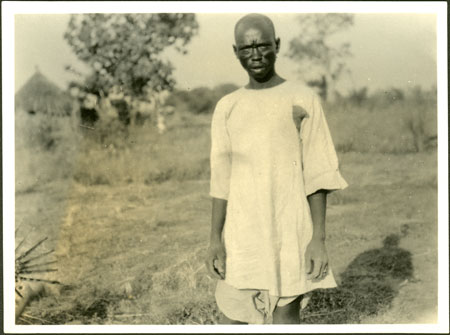Gumuz man

103 x 76 mm | Print gelatin silver
There are records relating to alternative images that we do not have scans for in the database:
1998.344.207.1 - Negative film nitrate , (103 x 76 mm)
1998.344.207.1 - Negative film nitrate , (103 x 76 mm)
Condition:
severe Residual chemical staining [EE 1989]
Date of Print:
Unknown
Previous PRM Number:
EP.D.207
Previous Other Number:
A 1
Accession Number:
1998.344.207.2
Description:
A three-quarter length portrait of a man (identified as the Gumuz chief) wearing an arabic-style white tunic.
Evans-Pritchard notes that he met a small colony of these people, who had come from western Ethiopia in small groups over the years, around Roseires.
They were (and are) predominantly muslim and besides agriculture kept small numbers of cattle and other livestock.
This seems to have been the first image taken by Evans-Pritchard when preparing for his Dar Fung tour of 1926.
Photographer:
Edward Evan Evans-Pritchard
Date of Photo:
1926 November
Region:
Blue Nile Roseires
Group:
Gumuz
PRM Source:
Edward Evan Evans-Pritchard
Acquired:
Donated 1966
Other Owners:
E. E. Evans-Pritchard Collection
Class:
Clothing , Physical Anthropology
Documentation:
Original catalogue lists in Manuscript Collections. Additional material in related documents files. [CM 27/9/2005]
Primary Documentation:
PRM Accession Records - Accession Book Entry [p.
98] 1966.27 [1 - 24] G[ift] PROFESSOR E.
E.
EVANS-PRITCHARD; INST.
OF SOCIAL ANTHROPOLOGY, 51 BANBURY RD.
OXFORD - 1966.27.19 - S.
SUDAN, DARFUNG.
VARIOUS TRIBES.
Box of negatives in envelopes, [1 - 242] & 1966.27.20 - Box of prints of these negatives [refers to object 1966.27.19] [1 - 242], in envelopes.
Manual Catalogues [typewritten, entitled "Ingassana"] - 207. Man - front view. (Gumus). A-1
Note on print reverse ms pencil - "Chief of Gumus Gumus A1"
Notes on card mount m/s pencil - "severe RCS 11/11/86 EE"
Manual Catalogues [typewritten, entitled "Ingassana"] - 207. Man - front view. (Gumus). A-1
Note on print reverse ms pencil - "Chief of Gumus Gumus A1"
Notes on card mount m/s pencil - "severe RCS 11/11/86 EE"
Other Information:
In Ethnological Observations in Dar Fung, Sudan Notes and Records Vol.XV, Part i, 1932 p.
47, E.
E.
Evans-Pritchard notes that '[t]hese Gumus inhabit a number of hills to the east of 35 degrees long., and between 11 and 12 degrees lat., e.g.
hills Barmandi, El Kili, Famaka, Belshongol, and Guba.
For some years they have been coming over the border into the Sudan in small numbers, to Roseires, Gallabat, etc.
I saw a small colony of them at Roseires ...
all members of the small community which I saw speak Arabic and profess Islam.
Their dress, furniture, and household utensils, are the same as one will see in any Arabic-speaking village in this area.
They are mainly agricultural, possessing a few cows, goats, sheep, dogs and chicken..' [Chris Morton 23/2/2004]
Recorder:
Christopher Morton 23/2/2004 [Southern Sudan Project]

